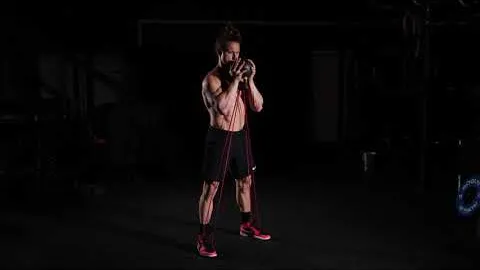
The banded kettlebell goblet squat is an effective lower body exercise designed to target multiple muscle groups while building strength and stability. Incorporating resistance bands into this exercise adds an additional challenge and helps activate the glutes and quads even further. In this article, we will explore the benefits, proper form, and variations of the banded kettlebell goblet squat to help you achieve your fitness goals.
Full-body workout: The banded kettlebell goblet squat engages several major muscle groups, including the quadriceps, glutes, hamstrings, core, and upper body. This makes it a highly efficient exercise for those looking to strengthen and tone multiple areas simultaneously.
Increased muscle activation: By incorporating resistance bands into the exercise, the banded kettlebell goblet squat intensifies the load and requires the muscles to work harder. This increased muscle activation can lead to greater strength gains and improved muscle definition.
Improved stability and balance: The goblet squat with a banded kettlebell challenges your balance and stability, particularly when performing the movement with a heavy weight. The resistance bands add an element of instability, forcing your muscles to work harder to maintain proper form throughout the exercise.
Enhanced core strength: The banded kettlebell goblet squat is a compound exercise that engages the muscles of the core to stabilize the spine and maintain an upright posture. This can help improve overall core strength and prevent lower back pain.
To maximize the effectiveness of the banded kettlebell goblet squat and prevent injury, it is crucial to maintain proper form throughout the movement. Follow these steps to ensure correct execution:
Starting Position: Stand with your feet slightly wider than shoulder-width apart, toes pointing slightly outward. Hold a kettlebell by the horns at chest level, close to your body. Loop a resistance band just above your knees.
Descend into the Squat: Initiate the movement by bending at the hips and knees, pushing your hips back as if sitting into a chair. Keep your chest lifted and your back straight, engaging your core muscles. Lower yourself until your thighs are parallel to the ground or as low as your mobility allows.
Drive through the Heels: Push through your heels to stand back up, extending your hips and knees simultaneously. Keep your chest lifted and your core engaged throughout the ascent. Make sure to maintain tension in the resistance band by pushing your knees outward.
Repeat: Complete the desired number of repetitions, maintaining proper form and control throughout each repetition.
To add variety to your lower body workouts and target different muscle groups, here are a few variations of the banded kettlebell goblet squat:
Banded Sumo Goblet Squat: Adopt a wider stance with your toes pointing outwards. Hold the kettlebell by the horns at chest level, close to your body, while keeping the resistance band above your knees. Perform the squat by descending deeper, targeting the inner thighs and glutes.
Banded Single-leg Goblet Squat: Stand on one leg, holding the kettlebell with both hands at chest level. Extend the opposite leg forward while maintaining balance. Squat down on the standing leg, pushing your hips back and keeping your chest lifted. This variation focuses on unilateral leg strength and stability.
Banded Pause Goblet Squat: Perform the banded kettlebell goblet squat as described earlier, but pause for a few seconds at the bottom of the squat position. This variation increases time under tension, further challenging your muscles and fostering greater strength gains.
Incorporating the banded kettlebell goblet squat into your lower body workouts can yield significant benefits, including increased muscle activation, improved stability, and enhanced core strength. By following proper form and trying out variations, you can make this exercise a cornerstone of your strength training routine. Remember to start with lighter weights and gradually increase resistance as you become more comfortable and confident in your technique. Enjoy the challenge and reap the rewards of a stronger, more sculpted lower body.
If you're looking for a gym, fitness club or yoga studio, you've come to the right place.
You can find information about gyms in your area. Browse catalog of gyms and find gyms with classes which are you looking for.
On gym page you can find simple information like address, phone or website. You can find list of available classes. You can check availability of personal training or small group classes. On place page you can also see information about open hours.
You can find gyms near you with amenities, courts, studios and equipments.
Use our map to find gym at your city or district.
In Gym Navigator you can find list of exercises with movies for many body parts.
You can browse exercises catalog and find exercises the best of you.
You can also find exercises grouped into workout plans, which you can use to improve you body. Each routine show you exercises one by one and give you possibility to count you progress and count down rest time.